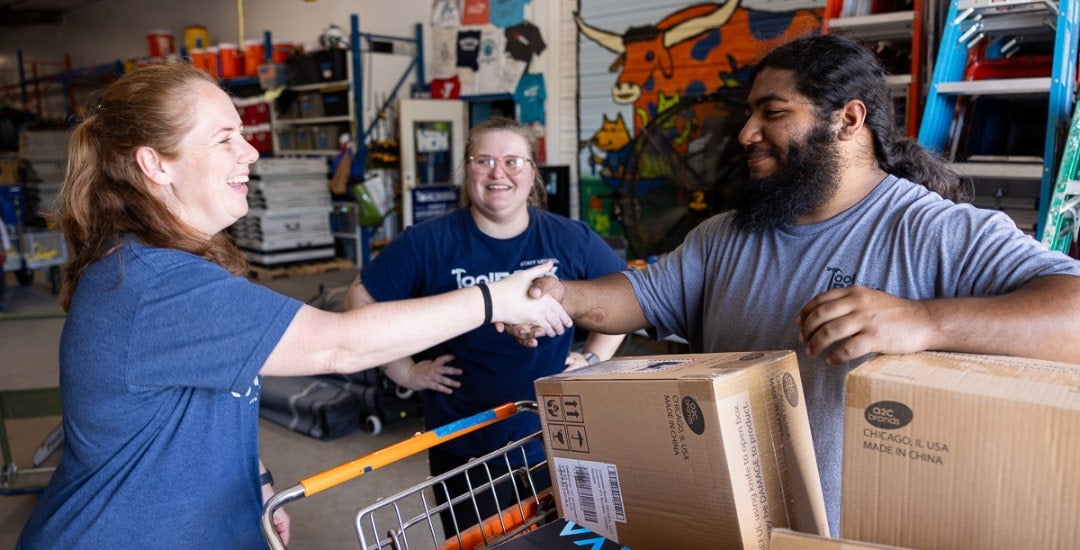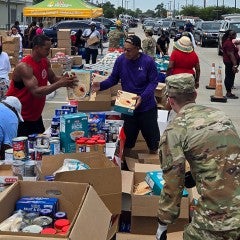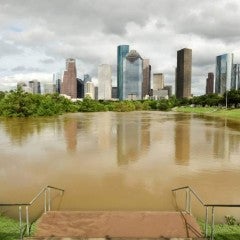Established in May 2023 by Greater Houston Community Foundation and United Way of Greater Houston, and in close partnership with the city of Houston and Harris County, the Greater Houston Disaster Alliance is focused on mitigating the repeated harm that the region’s most vulnerable neighbors experience and supporting local social infrastructure by making recovery resources more efficient and more accessible, and by supporting public-private partnerships across local, state and federal levels.
Strengthening networks for efficient recovery
In its inaugural year, the Disaster Alliance focused on engaging city and county leadership, streamlining critical processes, and reengaging with more than 200 local nonprofit organizations after more than three years without a declared disaster. Nonprofits were introduced to the Disaster Alliance’s strategic model and onboarded into our grantmaking system, allowing for the collection of critical information ahead of hurricane season.
These efforts paid off when, in its second year, two federally declared disasters hit the Houston region in quick succession. The Disaster Alliance swiftly mobilized, launching two funds that raised over $9 million to support 31 nonprofits that have served more than 4,000 households to date. (Midterm Impact Reports are now available for the Derecho Recovery Fund and Beryl Recovery Fund. A final report on the Derecho fund is now available, with a final Beryl report expected later in May.)
Thanks to investment in and collaboration with nonprofit partners, the average number of days from disaster to Round 1 grants was reduced by 12 days. By identifying where nonprofits have built deep relationships and by leveraging geographic service data, disproportionately impacted low-income communities can also now be more rapidly identified and prioritized.
To further expedite recovery efforts, the Disaster Alliance plans to make conditional agreements ahead of the 2025 hurricane season with a group of nonprofit partners who would be positioned to receive grant funds ideally within two weeks of a disaster.
Making recovery resources more accessible
The Disaster Alliance’s Flexible Emergency Financial Assistance program provides up to $1,500 per household to cover disaster relief and recovery expenses like temporary housing, relocation, food/furniture replacement, or to replace lost wages. This is a critical resource, as more than half of workers lost income and about half of households lost at least $250 in food not once but twice as a result of 2024’s disasters, according to the Kinder Institute for Urban Research.
These impacts can overwhelm the 46% of households that cannot afford a $400 emergency. In 2024, 95% of our Derecho Fund recipients made 50% of the area median income (AMI) or under; for the Beryl Fund, 67% of households earned 50% of the AMI or less. (AMI varies based on household size; the 2024 AMI for a family of four was $94,600, which would make 50% AMI $47,300.)
Many individuals face barriers in accessing traditional financial assistance due to being unbanked or underbanked, lacking access to direct deposits or checks, or incurring high banking fees. That’s why the Disaster Alliance asks grantees to provide financial assistance directly to households with at least two low-barrier options, such as checks, gift cards, and peer-to-peer payment apps.
The Disaster Alliance’s partnership with Connective aims to restore habitability and stabilize homes. Beginning as “Harvey Home Connect” in response to the overwhelming need and robust programs following Hurricane Harvey, Connective has helped standardize services, intake, eligibility verification, and referrals to home repair nonprofits. This approach helped our community prioritize highly vulnerable survivors and address more complex cases. Connective also supports nonprofits through program requirements, troubleshoots new issues, and assists with centralized reporting on behalf of grantees.
Providing this support ensures nonprofits can move swiftly to help people and families can access the resources they need to accelerate recovery.
Bridging gaps through public-private partnerships
When disasters strike, public recovery resources—especially federal assistance—play a vital role. In response to the 2024 disasters, FEMA processed hundreds of thousands of applications and distributed over $1 billion across the affected region, providing an essential foundation for long-term recovery.
Local leadership has also been critical. Harris County and the city of Houston, alongside elected leaders in Fort Bend, Montgomery, and Waller counties, have worked tirelessly to advocate for federal support, coordinate disaster volunteers, expedite recovery efforts, and strengthen disaster response systems. Their commitment sets the tone for the partnerships needed to help the Houston area recover more quickly and effectively.
The Disaster Alliance’s partnerships with elected officials across its four-county area are helping to solidify coordinated strategies that move the needle not only after disasters, but also between them. Meanwhile, key data-sharing partnerships with the Texas Department of Emergency Management and FEMA are helping the Disaster Alliance more thoughtfully allocate resources to nonprofits.
Even with strong public leadership and significant federal investment, recovery timelines can be long and complex—often involving multiple layers of damage assessments, federal declarations, and program activations. Public dollars also come with strict guidelines that can limit how and when funds reach households. Understanding these realities, private philanthropy can help fill critical gaps. Much like Houston’s nationally recognized success in addressing homelessness, public-private collaboration can make Houston a model for disaster recovery and resilience.
A commitment to social infrastructure
Social infrastructure — the institutions, churches, nonprofits, resilience hubs, and even neighbors helping neighbors — plays a critical role in reducing barriers and accelerating recovery.
Barriers to accessing resources — not knowing where to find help, denials, burdensome documentation requirements, and inconsistent and conflicting information all contribute to a slower recovery and can compound the negative impact that disasters have on survivors.
Through its work to elevate local disaster philanthropy, strengthen networks, bridge gaps through partnerships, and make resources more accessible, the Disaster Alliance is strengthening the social infrastructure that is so critical not just year-round but also during times of crisis.
Sara Martinez is the senior director of community impact at Greater Houston Community Foundation. Brooke Campbell, CNP, CVA is director of community outreach and disaster recovery at United Way of Greater Houston.
The views, information or opinions expressed in Urban Edge posts are those of the authors and do not necessarily represent those of the Kinder Institute for Urban Research.



